04: (a) Nitrogen occurs naturally as 2 isotopes: N-14 and N-15 O Nitrogen has an atomic number of 7. Suppose it gains 3 electrons. Draw the structure of N ion which is formed, write down its formula and state whether it is a cation or an anion. (i) The abundance of N-14 and N-15 are 99.6% and 0.4% respectively. What is the atomic mass of N? Show all your working clearly. (iii) Write down the formula for the element Nitrogen (b) Isotopes of certain elements, such as carbon-14 can be used in biochemical and medical research. The second isotope of these elements is radioactive, is called a radioisotope and is used in research because it has the same chemical properties as the non-radioactive isotope. Why are the chemical properties of all isotopes of the same element identical?
04: (a) Nitrogen occurs naturally as 2 isotopes: N-14 and N-15 O Nitrogen has an atomic number of 7. Suppose it gains 3 electrons. Draw the structure of N ion which is formed, write down its formula and state whether it is a cation or an anion. (i) The abundance of N-14 and N-15 are 99.6% and 0.4% respectively. What is the atomic mass of N? Show all your working clearly. (iii) Write down the formula for the element Nitrogen (b) Isotopes of certain elements, such as carbon-14 can be used in biochemical and medical research. The second isotope of these elements is radioactive, is called a radioisotope and is used in research because it has the same chemical properties as the non-radioactive isotope. Why are the chemical properties of all isotopes of the same element identical?
Chemistry: Principles and Reactions
8th Edition
ISBN:9781305079373
Author:William L. Masterton, Cecile N. Hurley
Publisher:William L. Masterton, Cecile N. Hurley
Chapter2: Atoms, Molecules, And Ions
Section: Chapter Questions
Problem 90QAP: Calculate the average density of a single Al-27 atom by assuming that it is a sphere with a radius...
Related questions
Question

Transcribed Image Text:04: (a) Nitrogen occurs naturally as 2 isotopes: N-14 and N-15
Nitrogen has an atomic number of 7. Suppose it gains 3 electrons. Draw the
structure of N ion which is formed, write down its formula and state whether it is a
cation or an anion.
(1)
The abundance of N-14 and N-15 are 99.6% and 0.4% respectively. What is the
atomic mass of N? Show all your working clearly.
(ii)
Write down the formula for the element Nitrogen
(b) Isotopes of certain elements, such as carbon-14 can be used in biochemical and medical
research. The second isotope of these elements is radioactive, is called a radioisotope and
is used in research because it has the same chemical properties as the non-radioactive
isotope. Why are the chemical properties of all isotopes of the same element identical?
O O D
Expert Solution
This question has been solved!
Explore an expertly crafted, step-by-step solution for a thorough understanding of key concepts.
Step by step
Solved in 2 steps with 1 images

Knowledge Booster
Learn more about
Need a deep-dive on the concept behind this application? Look no further. Learn more about this topic, chemistry and related others by exploring similar questions and additional content below.Recommended textbooks for you

Chemistry: Principles and Reactions
Chemistry
ISBN:
9781305079373
Author:
William L. Masterton, Cecile N. Hurley
Publisher:
Cengage Learning

Chemistry: Principles and Practice
Chemistry
ISBN:
9780534420123
Author:
Daniel L. Reger, Scott R. Goode, David W. Ball, Edward Mercer
Publisher:
Cengage Learning

Chemistry for Engineering Students
Chemistry
ISBN:
9781337398909
Author:
Lawrence S. Brown, Tom Holme
Publisher:
Cengage Learning

Chemistry: Principles and Reactions
Chemistry
ISBN:
9781305079373
Author:
William L. Masterton, Cecile N. Hurley
Publisher:
Cengage Learning

Chemistry: Principles and Practice
Chemistry
ISBN:
9780534420123
Author:
Daniel L. Reger, Scott R. Goode, David W. Ball, Edward Mercer
Publisher:
Cengage Learning

Chemistry for Engineering Students
Chemistry
ISBN:
9781337398909
Author:
Lawrence S. Brown, Tom Holme
Publisher:
Cengage Learning

Chemistry: An Atoms First Approach
Chemistry
ISBN:
9781305079243
Author:
Steven S. Zumdahl, Susan A. Zumdahl
Publisher:
Cengage Learning

Chemistry
Chemistry
ISBN:
9781305957404
Author:
Steven S. Zumdahl, Susan A. Zumdahl, Donald J. DeCoste
Publisher:
Cengage Learning
